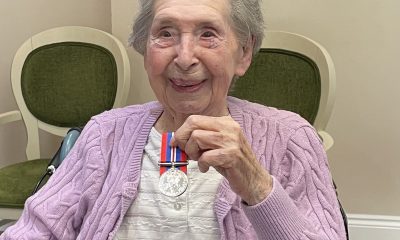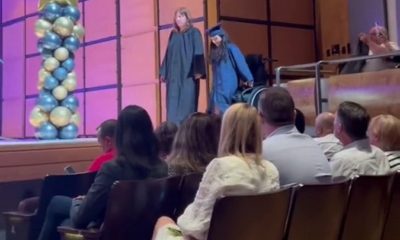When old couples are close together, their heart rates synchronize
Published
2 years ago onBy
Talker NewsBy Georgia Lambert via SWNS
When old couples are physically close their hearts beat together, according to a new study.
They found that when partners are close to each other, their heart rates synchronize in complex patterns of interaction.
Researchers from the University of Illinois explained the dynamics of long-term relationships by looking at spatial proximity.
As couples grow old together, their interdependence grows, and often, they become each other’s primary source of physical and emotional support.
It is known that long-term marriages can have a profound effect on health and well-being, but the benefits do depend on the quality of the relationship.
Brian Ogolsky, an associate professor in the Department of Human Development and Family Studies at the university, was the study’s lead author.
He said: “Relationship researchers typically ask people how they're doing and assume they can recall properly and give meaningful answers.
"But as couples age and have been together for a long time, they laugh when we ask them how satisfied or how committed they are.
“When they have been married for 30 or 40 years, they feel that indicates commitment in itself.”
The professor added: “We were looking for more objective ways to measure relationship dynamics, and we know that being around other people has psychological benefits. So, physical proximity seemed like a strong candidate.”

Professor Ogolsky went on to stress that just being close to another person isn’t always the best idea and for the couple to reap the benefits, it has to depend on the nature of the interaction.
Closeness, in the context of a conflict, is very different from closeness in the context of loving interactions.
Similarly, changes in heart rate can be positive or negative.
Professor explained: “We’re not focusing on cause and effect, but on co-regulation, which happens when heart rates move in an asynchronous pattern.
“That is, when the partners are close, their heart rate patterns indicate an interaction that is collectively meaningful in some way.”
The study included ten heterosexual, married couples, aged 64 to 88, who had been in their relationships for 14 to 65 years.
They were each followed by a researcher for two weeks, who continuously tracked their heart rates and their proximity to each other when at home.
The participants wore a Fitbit to measure their heart rate and a small proximity-sensing device.
The team installed sensors in the home that allowed them to monitor the devices and observe how physically close the spouses were to each other.
By setting the study up in this way, the researchers were able to correlate all three measures - each partner’s heart rate and the couple’s proximity - in real-time.
The researchers called the couples each morning to remind them to put on the Fitbit and tracking devices, and again in the evening to survey them about their health and well-being, while also getting the low-down on their relationship dynamics throughout the day.
Professor Ogolsky said: “Our first step was to see if heart rate and proximity are correlated over time.
"We looked at the husband's heart rate with proximity, the wife's heart rate with proximity, and the two heart rates with each other.
“We also wanted to know if all three-time series worked together to give us unique information.
“Can we use any of them to predict the others? And the answer is yes. All three-time series need to be included for us to be able to predict any one of them well.”
The study’s findings indicated a “lead-lag relationship” in the synchronization of their heart rates, where one partner leads and the other follows.
Sometimes the wife’s heart rate would lead the change and at other times, the husband’s would.
Professor Ogolsky explained what this meant: “This suggests a delicate balance. When one partner triggers the other partner, they start a unique couple-level dance that affects their physiology and their patterns throughout the day.”
Because of the small number of participants, the study didn’t include comparisons between couples. But even within the couples, no clear patterns emerged.
Professor Ogolsky explained: “We found each day is a unique context that changes depending on circumstances.
"Couple interactions, their attitudes, behaviors, whether they're close to each other or far away, change all the time.
“Even across 14 days, couples are not consistent enough in these kinds of objective patterns to allow us to make any couple-level conclusions. We can only make day-level predictions.”
According to the research team, this finding is an important contribution to the body of knowledge on relationships.
Professor Ogolsky said: “If we really want to understand the unique patterns of interaction that happen within couples, we need to start focusing our attention on micro-processes; the small interaction patterns that accumulate over a day.
"Those tell us about the nature of how couples’ interactions play out from moment to moment.”
The study was published in the Journal of Social and Personal Relationships.
Stories and infographics by ‘Talker Research’ are available to download & ready to use. Stories and videos by ‘Talker News’ are managed by SWNS. To license content for editorial or commercial use and to see the full scope of SWNS content, please email [email protected] or submit an inquiry via our contact form.
You may like


Losing weight reduces risk of developing cancerous growths, new study reveals


Women fake orgasms to make men feel more macho, new study suggests


Gold rush transformed ‘pristine’ Amazon rainforests into ‘toxic’ wastelands


People with long COVID may have lung damage that doesn’t show up in routine testing


Synthetic blood cells could help stop people from bleeding to death


Why coffee and avocado toast could quickly become a thing of the past
Other Stories


Blood test can detect signs of knee condition 8 years before X-rays
Early detection could lead to treatments that slow the progression of the most common form of arthritis.


Man captures ultra rare albino squirrel on camera
The white squirrel has red eyes so is thought to be an albino squirrel.


Adorable dog kicks his leg while he walks
A video captured the pup bouncing along the street of his native China.


Woman with rare ‘Sleeping Beauty’ condition sleeps every four hours
She was diagnosed at age 18 after years of struggling to stay awake in school and nodding off during class.


97-year-old veteran receives WWII service medal 80 years later
"We’re all so proud of Eve."
Top Talkers

 Parenting1 week ago
Parenting1 week agoSingle mom details struggles of feeding her 12 kids

 Lifestyle1 week ago
Lifestyle1 week agoWoman regrets her tattoo nightmare: ‘It’s horrendous’

 Good News4 days ago
Good News4 days agoDisabled student takes first steps in 10 years on graduation stage

 Wildlife3 days ago
Wildlife3 days agoClever elephant returns visitor’s shoe that fell into enclosure

 Health4 days ago
Health4 days agoNew study reveals ‘old age’ begins later than it used to

 Entertainment1 day ago
Entertainment1 day agoWhat is the perfect movie length?

 Broadcast10 hours ago
Broadcast10 hours agoAre allergies interfering with your social life?

 Work2 days ago
Work2 days agoHow much does your workspace affect productivity?

